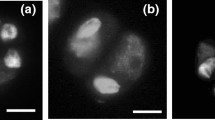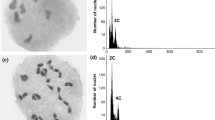Abstract
Sex can sometimes lead to complications. In some crops, 2n gametes have been exploited by plant breeders to transfer genetic variation between taxa of different ploidy levels. However, their role and use in dioecious genera have received relatively little attention. In the dioecious genus Actinidia (kiwifruit), seedling populations usually segregate equally for females and males as sex is determined by an XX female/XY male system. While fertilization involving 2n egg cells is not expected to affect the sex ratios of progenies, fertilization involving 2n pollen is likely to produce progenies with excess males. The extent of sex ratio distortion will depend on the relative contributions of first and second division restitution, and the frequency and location of cross-overs in meiosis. In this study, seedlings recovered from crosses between females of hexaploid Actinidia deliciosa and males of two diploid species, Actinidia chinensis and Actinidia eriantha, included a proportion of pentaploid hybrids presumably derived from fertilization involving 2n pollen. Most of these pentaploids were male, and a proportion of them were likely to be carrying two Y chromosomes. If used as parents in further crosses, males with multiple Y chromosomes are likely to cause distorted sex ratios in their immediate progenies. In dioecious genera such as Actinidia, the effects on sex ratios of different mechanisms of ploidy change need to be taken into account when considering the evolution of polyploidy and the design of breeding strategies involving ploidy manipulation.

Similar content being viewed by others
References
Anon (2010) Zespri’s new varieties—growing the category. N. Z. Kiwifruit J 200:8–11
Barcaccia G, Tavoletti S, Mariani A, Veronesi F (2003) Occurrence, inheritance and use of reproductive mutants in alfalfa improvement. Euphytica 133:37–56
Bretagnolle F, Thompson JD (1995) Gametes with the somatic chromosome number: mechanisms of their formation and role in the evolution of autopolyploid plants. New Phytol 129:1–22
Carputo D, Barone A (2005) Ploidy level manipulations in potato through sexual hybridisation. Ann App Biol 146:71–79
Carputo D, Barone A, Frusciante L (2000) 2n gametes in the potato: essential ingredients for breeding and germplasm transfer. Theor Appl Genet 101:805–813
Carputo D, Frusciante L, Peloquin SJ (2003) The role of 2n gametes and endosperm balance number in the origin and evolution of polyploids in the tuber-bearing Solanums. Genetics 163:287–294
Chat J, Dumoulin PY (1997) Flow cytometry and RAPD markers applied to parentage analysis within Actinidia genus. Acta Hortic 444:109–111
Ferguson AR, Huang H-W (2007) Genetic resources of kiwifruit: domestication and breeding. Hort Rev 33:1–121
Fraser LG, Tsang GK, Datson PM, De Silva HN, Harvey CF, Gill GP, Crowhurst RN, McNeilage MA (2009) A gene-rich linkage map in the dioecious species Actinidia chinensis (kiwifruit) reveals putative X/Y sex-determining chromosomes. BMC Genomics 10:102
Gill GP, Harvey CF, Gardner RC, Fraser LG (1998) Development of sex-linked PCR markers for gender identification in Actinidia. Theor Appl Genet 97:439–445
Harlan JR, deWet JMJ (1975) On Ö. Winge and a prayer: the origins of polyploidy. Bot Rev 41:361–390
Harvey C, Gill GP, Fraser LG, McNeilage MA (1997) Sex determination in Actinidia 1. Sex-linked markers and progeny sex ratio in diploid A. chinensis. Sex Plant Reprod 10:149–154
He ZC, Huang HW, Zhong Y (2003) Cytogenetic study of diploid Actinidia chinensis—karyotype, morphology of sex chromosomes at primary differentiation stage and evolutionary significance. Acta Hortic 610:379–385
Li XW, Li JQ, Soejarto DD (2007) New synonyms in Actinidiaceae from China. Acta Phytotaxon Sin 45:633–660
McNeilage MA (1997) Progress in breeding hermaphrodite kiwifruit cultivars and understanding the genetics of sex determination. Acta Hortic 444:73–78
Mizugami T, Kim JG, Beppu K, Fukuda T, Kataoka I (2007) Observation of parthenocarpy in Actinidia arguta selection ‘Issai’. Acta Hortic 753:199–203
Ortiz R (1998) Potato breeding via ploidy manipulations. Plant Breed Rev 16:15–86
Peloquin SJ, Boiteux LS, Carputo D (1999) Meiotic mutants in potato: valuable variants. Genetics 153:1493–1499
Ramanna MS, Jacobsen E (2003) Relevance of sexual polyploidization for crop improvement—A review. Euphytica 133:3–18
Ramsey J, Schemske DW (1998) Pathways, mechanisms and rates of polyploid formation in flowering plants. Ann Rev Ecol Syst 29:467–501
R Development Core Team (2008) R: a language and environment for statistical computing. R Foundation for Statistical Computing, Vienna, Austria. ISBN 3-900051-07-0. www.R-project.org
Testolin R, Cipriani G, Costa G (1995) Sex segregation ratio and gender expression in the genus Actinidia. Sex Plant Reprod 8:129–130
Veilleux R (1985) Diploid and polyploid gametes in crop plants: mechanisms of formation and utilization in plant breeding. Plant Breed Rev 3:253–288
Wu JH, Mooney P (2002) Autotetraploid tangor plant regeneration from in vitro Citrus somatic embryogenic callus treated with colchicine. Plant Cell Tiss Organ Cult 70:99–104
Wu JH, Ferguson AR, Murray BG (2009) In vitro induction of autotetraploid Actinidia plants and their field evaluation for crop improvement. Acta Hortic 829:245–250
Yan G-J, Ferguson AR, McNeilage MA, Murray BG (1997) Numerically unreduced (2n) gametes and sexual polyploidization in Actinidia. Euphytica 96:267–272
Acknowledgments
We thank Canhong Cheng, Jonathan Dixon, Alison Duffy, Juanita Dunn, Tim Holmes, Luis Gea, Kirsten Hoeata, Bart Hofstee, Russell Lowe, Nicky Paterson and research orchard staff (Plant & Food Research) for their assistance with this project, and Dr Brian Murray of the University of Auckland for commenting on an earlier draft.
Author information
Authors and Affiliations
Corresponding author
Additional information
Communicated by Hugh Dickinson.
Rights and permissions
About this article
Cite this article
Seal, A.G., Ferguson, A.R., de Silva, H.N. et al. The effect of 2n gametes on sex ratios in Actinidia . Sex Plant Reprod 25, 197–203 (2012). https://doi.org/10.1007/s00497-012-0191-6
Received:
Accepted:
Published:
Issue Date:
DOI: https://doi.org/10.1007/s00497-012-0191-6




